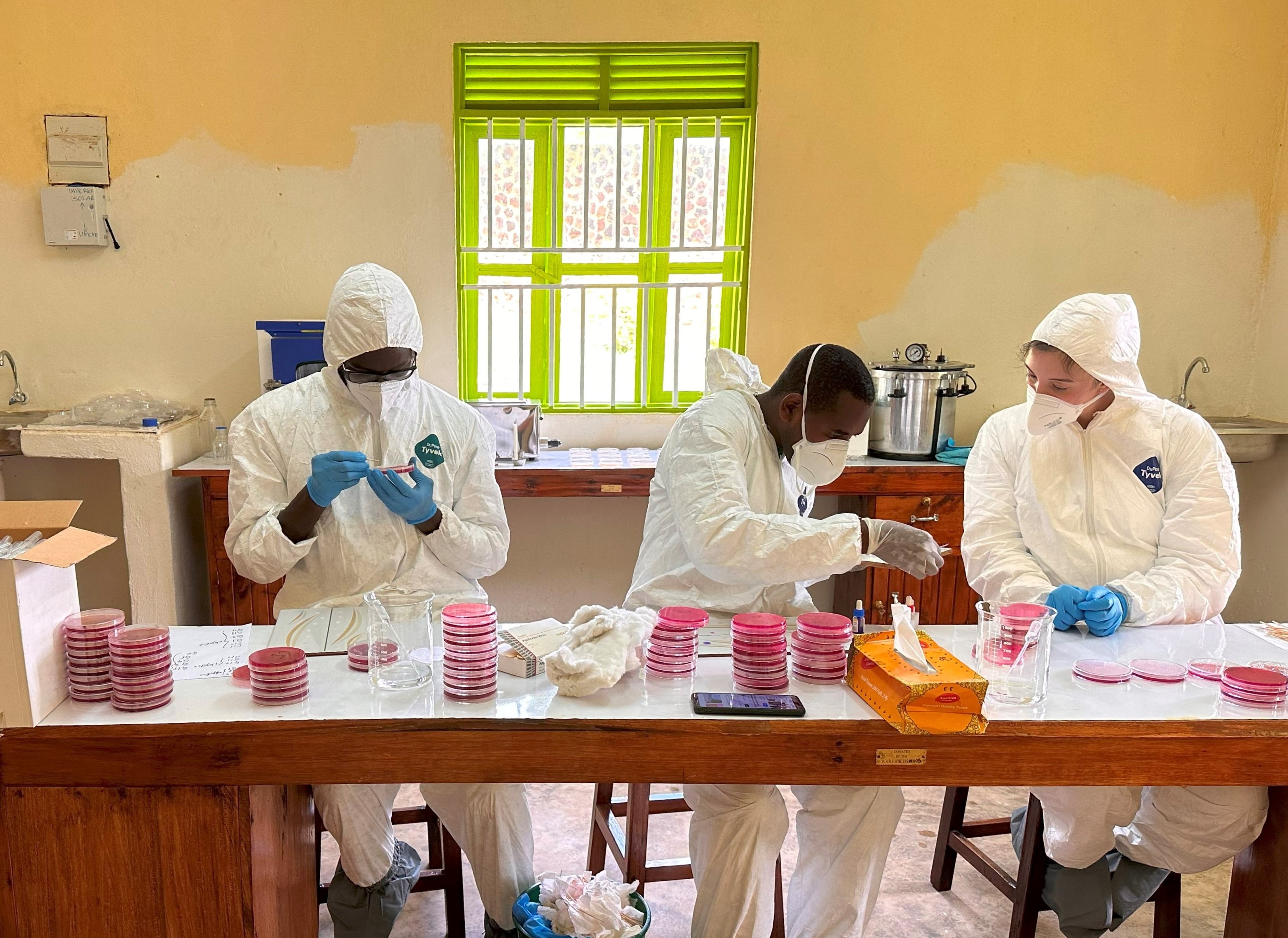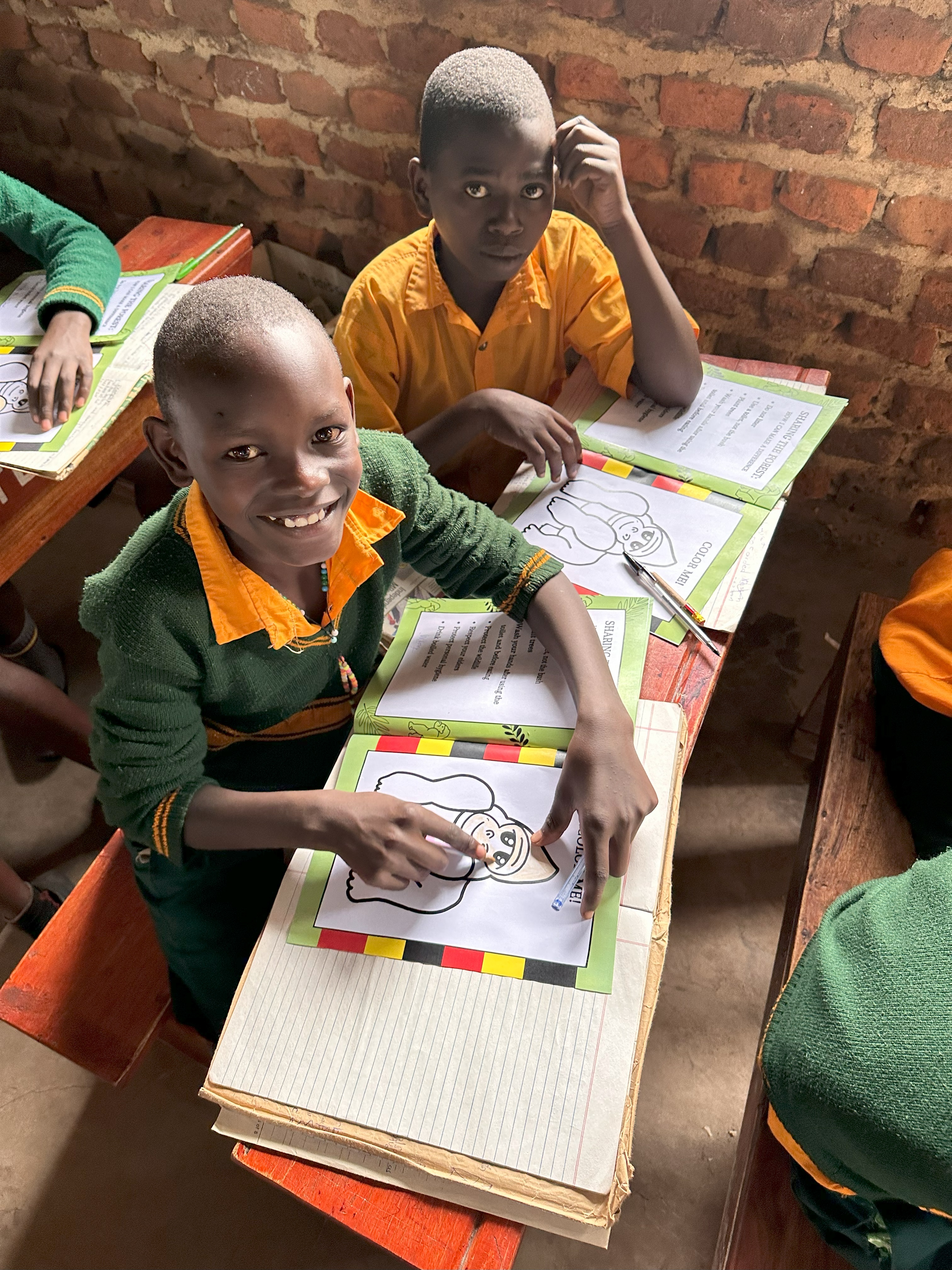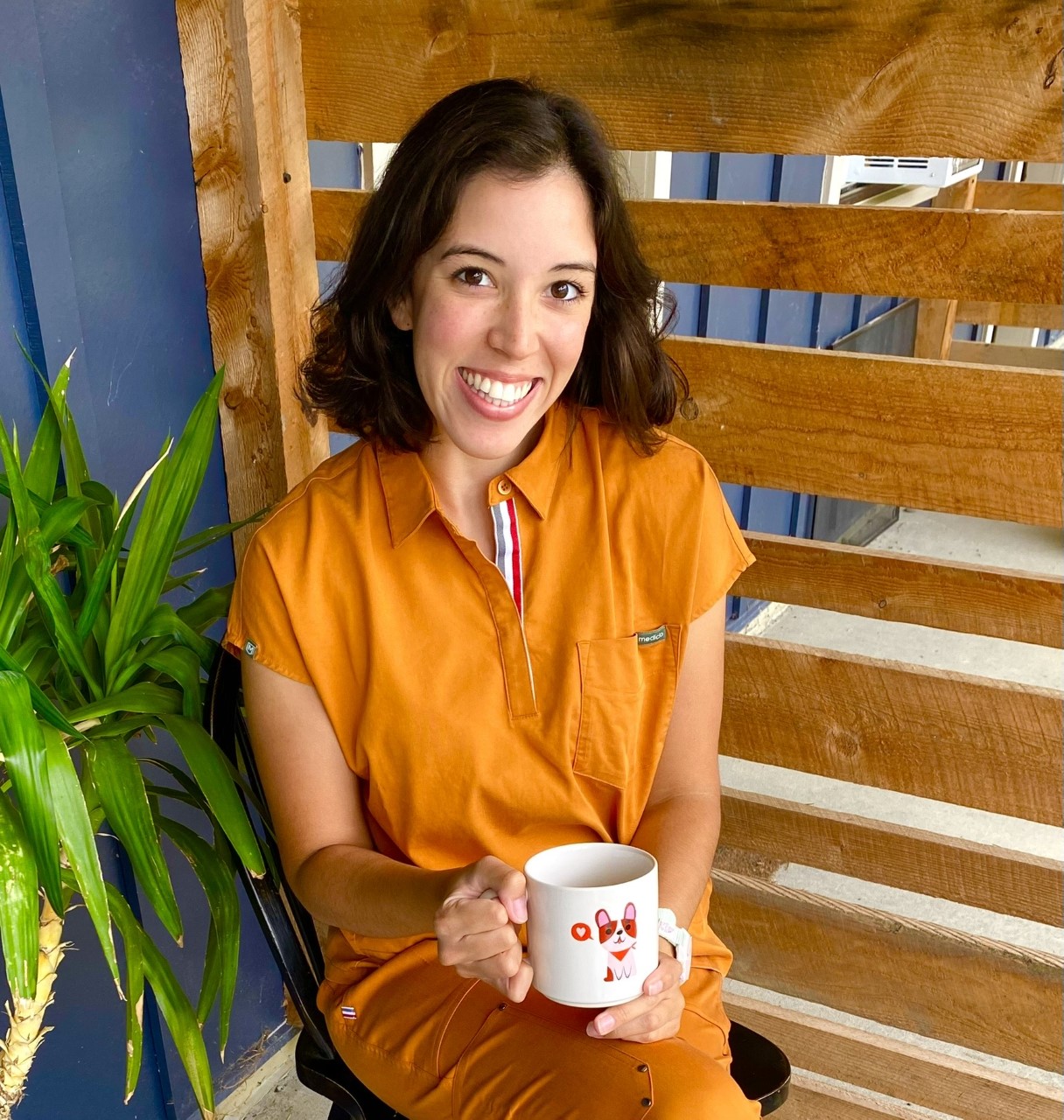Learning to ‘Walk with Gorillas’ in Bwindi Impenetrable National Park
By Carolina Baquerizo, Cornell DVM '24
Working with primates is something I had avoided for a while. Most of my interest has been in southern Africa, with ungulates like giraffes, antelope, and pachyderms being my main focus. Yet I felt that, following the COVID-19 pandemic, learning more about wild primate health would be vital. I connected with Dr. Gladys Kalema-Zikusoka’s organization, Conservation Through Public Health (CTPH). I was accepted at CTPH as a veterinary extern after applying, completing an interview, and brainstorming about potential research projects. As a Cornell University College of Veterinary Medicine (CVM) Expanding Horizons program grant recipient, plans to travel to Uganda commenced!
On arrival in Entebbe, a city in central Uganda near Lake Victoria, the CTPH team took me out for a Ugandan welcome lunch of matoke (made from mashed plantains), beans, cassava, chapati (flatbread), and fish. I was nervous about coming with a pescatarian/vegetarian diet, but I had plenty of options and the food was spectacular! From the moment I met them, the team welcomed me as family and immediately included me in everything happening at CTPH. It was so rewarding to train with an organization that not only provided an engaging environment and the opportunity to learn new skills and techniques, but also valued my time and experience and sought to include me in their work.
My first days in Uganda were spent finalizing project research design and planning the domestic trip to Bwindi Impenetrable National Park. I planned to continue the work started by CTPH and Dr. William Fugina, a fellow Cornellian (DVM ’19) who also came to Uganda as an Expanding Horizon student several years ago. CTPH’s Mr. Stephen Rubanga, Dr. Mark Okot, and Dr. Gladys prepared me mentally for the intense work needed in Bwindi; collecting samples from gorillas, livestock, and people in a short period of time would be quite the challenge. It was time to get my head in the game! I was going to be flying to Bwindi in advance of the rest of the research team to get acclimated to the region.
I knew I would be taking a small plane to Bwindi, and when I arrived at the airport, I discovered how small it actually was: eight seats, and I was sitting right behind the pilot. Along the rest of the airstrip were other private charters and planes owned and operated by the United Nations. On our way to Bwindi, we stopped at Queen Elizabeth National Park (QENP) to drop off another researcher. Upon departing QENP, the pilot told me to sit on the aircraft’s left side. He surprised me with some low flying along the channel where hundreds of elephants, hippos, and Cape buffalo were bathing. It was a beautiful safari from the sky, and I’ll never forget the views I saw.
Let the Research Begin!
My research aimed to follow-up on data collected by CVM alumnus Dr. Fugina, who visited Bwindi during his time as a Cornell veterinary student to investigate the prevalence of Salmonella in livestock, gorillas, and people, given its risk as a zoonotic pathogen. We needed an adequate sample size from the same three groups (livestock, gorillas and people) and nearby water sources shared by those groups. Farmers and community members volunteered to submit human fecal samples for our research; CTPH has spent 20 years forming relationships with people in communities surrounding the park, and they were happy to be part of our research.
We alternated our days between collecting samples from livestock and from gorillas. For livestock, we visited multiple communities with cows, goats, and sheep. Obtaining permission to collect samples from endangered mountain gorillas is a lengthy process that began months before I arrived in Uganda. I am grateful for the Chief Warden’s approval for a student from Cornell to work with CTPH on data collection. Dr. Gladys had forewarned me of the intensity that tracking gorillas required, and I was up for the challenge. Our tracking group included Uganda Wildlife Authority (UWA) rangers, the CTPH laboratory technician Annaclet, and me. We set off before sunrise to locate the gorillas before tourism groups would even be close to arriving.
Finding the Gorillas, Returning to the Lab
The naming of Bwindi “Impenetrable” Forest became apparent shortly into my first tracking experience. Between altitude, plant growth, temperature, bugs, and uneven ground, this was hands-down the most intense hiking I have ever experienced. The light at the end of the tunnel was finding gorillas, which kept me motivated. Some days took longer than others, but I learned tracking techniques used by the UWA to follow habituated gorilla groups in Bwindi. Annaclet and the UWA rangers tested my skills by allowing me to lead and follow paths made by gorillas; my pass rate wasn’t great, but it got better over time.
I usually don’t choose favorites, but the Mubare gorilla family stole my heart. They were the first to be habituated in the national park, and with a history of habituation, they really didn’t mind being followed by the rangers and researchers. Of course, this meant they were more likely to get closer to community borders, but the UWA and CTPH managed such incidents effectively and shifted them back to the forest. An infant in the Mubare family was really interested in me. At first, he climbed into a tree next to me, and as I walked away to view the silverback, the infant followed me and climbed into the next nearest tree. The playful nature of the infant was beyond adorable!
We collected samples for our research from multiple gorilla families over several days. Gorillas build a new nest to sleep in every day, and conveniently, they defecate right next to it every morning. We utilized measurements to determine which samples came from which gorillas, and silver hairs in the nest helped us identify the silverback’s samples.
Following intense days of hiking, we committed ourselves to full-time laboratory work with early morning starts. Mr. Stephen, Dr. Mark, and Annaclet showed me the ropes, and we developed a great rapport in the lab that allowed us to work together effectively and efficiently. Though I had not been in a microbiology lab for a while, the methods I learned back in my undergraduate studies kicked in. We met all of our research goals as a team.
Designing and Implementing a Conservation Curriculum
My mom is an educator, and school has always been an important place for me. I spent lots of time learning outside the classroom and was interested in wildlife from a young age. I was first exposed to conservation messages as a young girl visiting my cousin at her job as a zookeeper. My career goals were a direct result of the information I was exposed to as an elementary-level student.
The opportunity to teach conservation to young children was first presented to me last summer in Zimbabwe. I took what I had learned during that experience to develop my own conservation curriculum materials for the children in Bwindi. Before I arrived in Bwindi, I had worked on preliminary illustrations and content for a children’s workbook with a friend. I presented the idea to CTPH, and they were happy to allow me to work with school-age children during my internship. Alongside the CTPH community officers, we made edits and finalized a 6-page children’s workbook to teach information about endangered mountain gorillas, public health in the community, and how students can make a difference. I hosted a lesson at St. Matthews Primary School in Bwindi for primary level five students.
I was nervous. Luckily, I had received help from education professionals and CTPH to assemble the workbook. Still, I couldn’t help but stress about language barriers, English proficiency levels, and other challenges that might make the book unsuccessful. We incorporated puzzles and drawing activities that I hoped the students would grasp. I was delighted that the students followed along well during the lesson, asked questions, stood up to answer questions, and remained focused. The workbook challenged them to draw, answer multiple-choice questions, and commit to making a difference! At the end of the lesson, the students retained the information we discussed during the class, and I gave them homework: to share the book and knowledge with their siblings at home.
See You Soon, Uganda!
Saying goodbye never gets easier. Leaving the Gorilla Conservation Camp in Bwindi was so hard. I made great friends and accomplished so much in a short period. The CTPH team in Entebbe didn’t make leaving any easier, either. When I arrived back in Entebbe, Lilian from the CTPH main office was waiting for me with flowers at the airport. Before leaving Uganda, one item was left on the agenda: to visit Makerere University’s veterinary school in Kampala, Uganda’s capital. This was my first time visiting a university in Africa, and I was keen to see what it was like. Makerere was an impressive institution, and I visited the veterinary clinic and diagnostic laboratories with Makerere alumni Dr. Mark Okot.
I appreciate the ongoing mentorship I receive today from CTPH, and I am so happy I stepped out of my comfort zone to work alongside mountain gorillas. Shortly after my return to the United States, Dr. Gladys visited Cornell on her book tour for her memoir, “Walking with Gorillas.” The following week, my mentor Dr. Steve Osofsky presented me with my white coat, and my friends from CTPH watched the live stream. I look forward to the day I can go back and visit.
I’d like to thank the following groups and individuals for supporting this experience: Cornell’s Expanding Horizons Committee, Cornell University College of Veterinary Medicine, Conservation Through Public Health, Dr. Gladys Kalema-Zikusoka, Dr. Steve Osofsky, Mr. Stephen Rubanga, Dr. Mark Okot, Mr. Lawrence Zikusoka, Dr. Kevin Cummings, Richard Bagyenyi, Annaclet Ampeire, Lilian, Jessica, Ssali, Kanie, Gracious, Morris, Martin, Ronald, Saul, and Dr. William Fugina.
Carolina Baquerizo is a fourth-year Cornell veterinary student in the Class of 2024. She received her B.S. in Biological Science from Florida State University. Carolina began volunteering at Zoo Miami when she was 15 and has had multiple zoological internships since then. She aspires to be a wildlife veterinarian working towards ex situ conservation goals focused on assisted reproduction in zoos and in situ goals focused on human-wildlife conflict and One Health.
All photos provided by Carolina Baquerizo.








